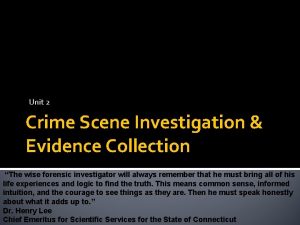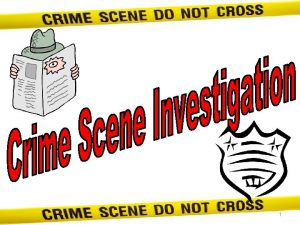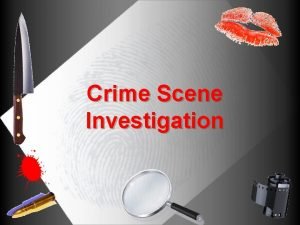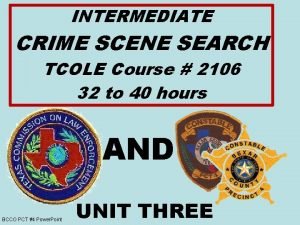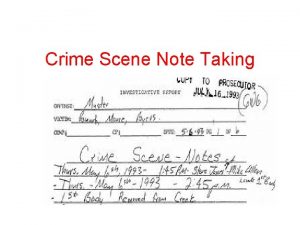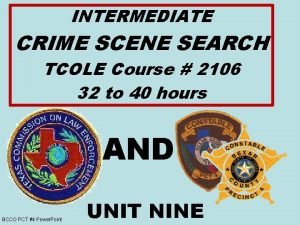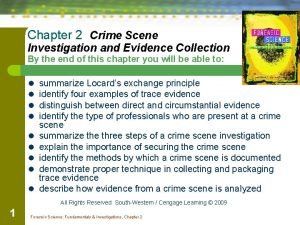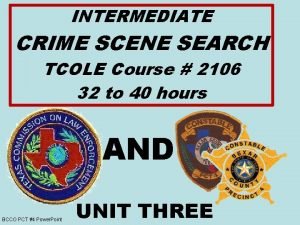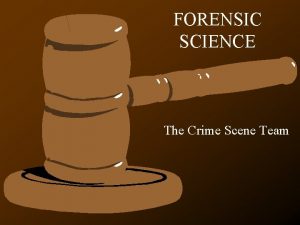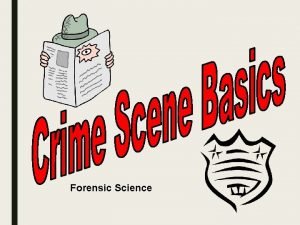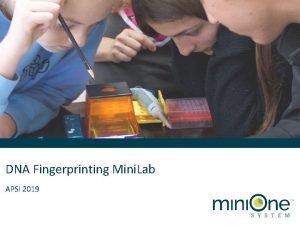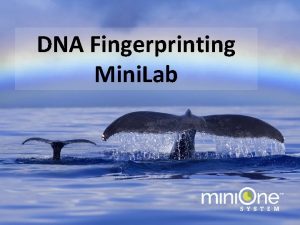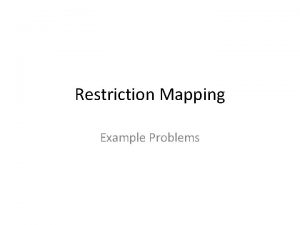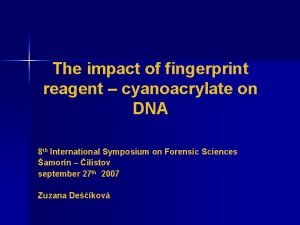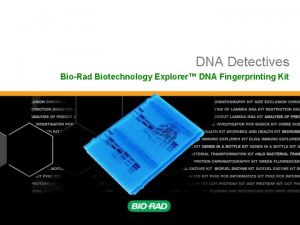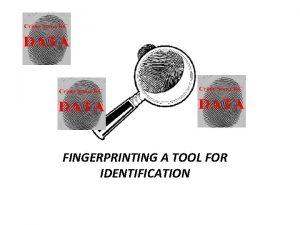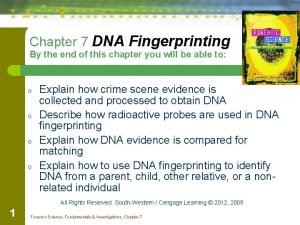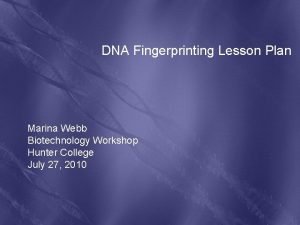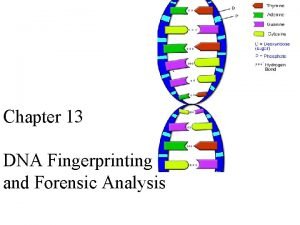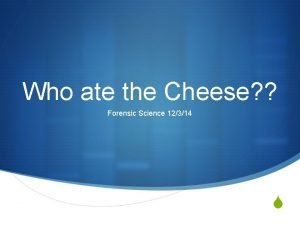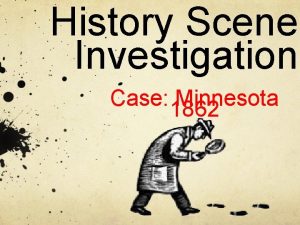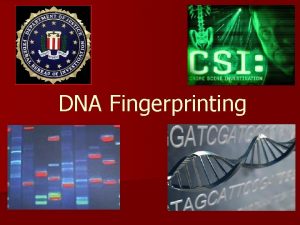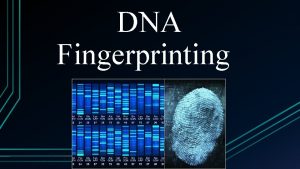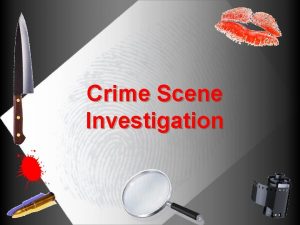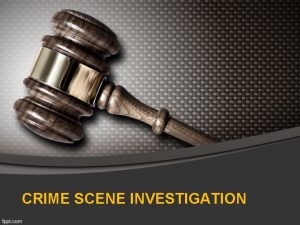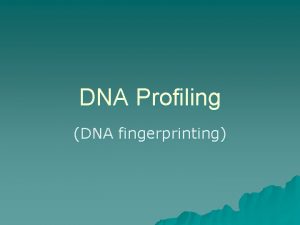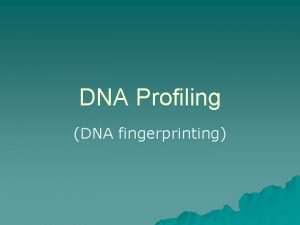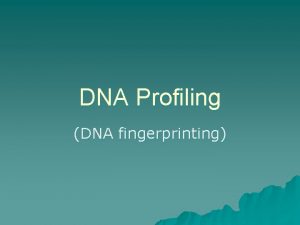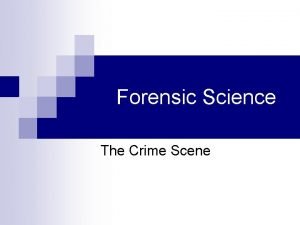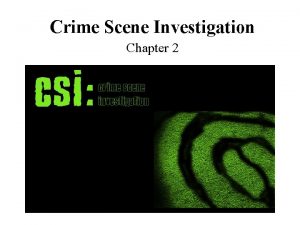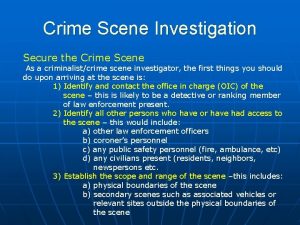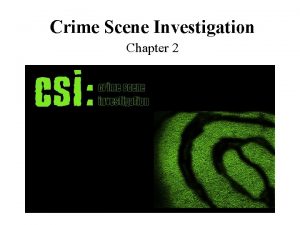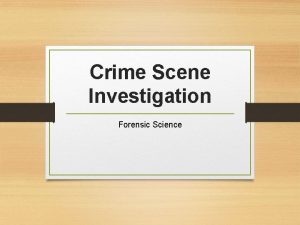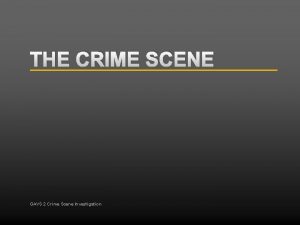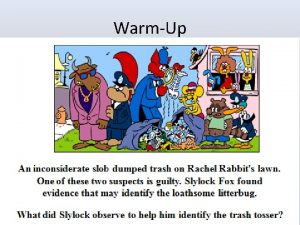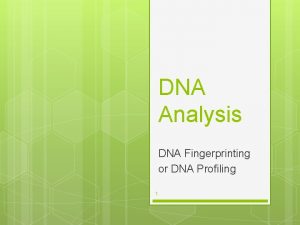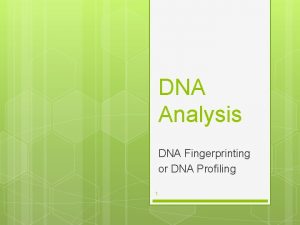Crime Scene Investigation DNA Profiling DNA Fingerprinting DNA


























- Slides: 26

Crime Scene Investigation DNA Profiling / DNA Fingerprinting DNA profiling is the use of molecular genetics methods to determine the exact genotype of a DNA sample to distinguish one human being from another Used in forensics to investigate crime scenes, missing persons, mass disasters, paternity, evolutionary links, … Crime scenes often contain biological evidence (blood, semen, hair, saliva, bones, skin) from which DNA can be extracted Humans have ~3 billion bp and >99. 5% do not vary, however a small percentage (<0. 5%) does differ Varying regions are called “polymorphic” due to nt differences between one individual and another and polymorphisms are in regions of our chromosome (called loci) that do not have any known function - this DNA is satellite DNA (specifically short tandem repeats/microsatellite)

Crime Scene Investigation DNA Profiling / DNA Fingerprinting Ways to detect unique sequences within mammalian DNA 1. Restriction digestion of chromosomal DNA works for some organisms BUT not in mammals: EX: humans have 3 billion base pairs with 1 million restriction fragments formed from a single restriction enzyme digest, nt differences between people will result in different restriction digestion products - but TOO difficult to isolate a single band on a gel from this large number of fragments 2. To characterize a specific gene use blot hybridization

Crime Scene Investigation DNA Profiling / DNA Fingerprinting

Crime Scene Investigation DNA Profiling / DNA Fingerprinting RFLPs Genome of each of us is unique (exception: identical twins) Variation in sequences between individuals is most pronounced in DNA that does not code for proteins Hypervariable regions called “polymorphic sites” Polymorphic sites - variation due to small insertions, deletions, or point mutations in restriction sites SO. . Restriction fragment with a polymorphic site may differ from one person to the next resulting in: RESTRICTION FRAGMENT LENGTH POLYMORPHISMS (RFLPs) Pattern of bands on a blot hybridization sometimes called a “DNA fingerprint” because can use it to identify an individual

Crime Scene Investigation DNA Profiling / DNA Fingerprinting History of Forensics Early use of science for criminal investigations - use of photographs to document crime scenes Past ~100 years - use of fingerprinting First genetic evidence collected for investigations - blood group typing (A, B, AB, and O) Test is very fast and straight-forward. BUT 40% of population is type O, so not useful if several suspects are type O. 1980 s - first use of DNA-based forensic test called restriction fragment length polymorphism analysis (RFLP); discovered by Alec Jeffries, focus on VNTRs (variable number of tandem repeats)

Crime Scene Investigation DNA Profiling / DNA Fingerprinting

Crime Scene Investigation DNA Profiling / DNA Fingerprinting Restriction fragment length polymorphism analysis (RFLP)

Crime Scene Investigation DNA Profiling / DNA Fingerprinting Restriction fragment length polymorphism analysis (RFLP)

Crime Scene Investigation DNA Profiling / DNA Fingerprinting Restriction fragment length polymorphism analysis (RFLP)

Crime Scene Investigation DNA Profiling / DNA Fingerprinting Restriction fragment length polymorphism analysis (RFLP)

Crime Scene Investigation DNA Profiling / DNA Fingerprinting Restriction fragment length polymorphism analysis (RFLP)

Crime Scene Investigation DNA Profiling / DNA Fingerprinting Restriction fragment length polymorphism analysis (RFLP)

Crime Scene Investigation DNA Profiling / DNA Fingerprinting Restriction fragment length polymorphism analysis (RFLP) Although technique is powerful and has great discriminating potential, it is laborious, cannot be easily automated and is time-consuming Depends on DNA sequences being several hundred base pairs in length, so DNA must be of reasonable quality (not degraded) and it requires a large amount of DNA (not always able to get enough DNA from the crime scene) SO turn to using STRs - short tandem repeat DNA (smaller repeat lengths than VNTRs) Easier to analyze than RFLPs because: 1. due to small size they are easily replicated by PCR 2. Because they can be amplified by PCR, STR tests can be automated, with several tests being run at the same time 3. Even degraded DNA can give OK results 4. Even a single piece of hair (or a drop of blood, cheek cell, or piece of bone) can give enough genetic material for successful analysis

Crime Scene Investigation DNA Profiling / DNA Fingerprinting Advances in PCR have made a huge impact MODERN FORENSIC DNA PROFILING MAKES IT POSSIBLE TO DISTINGUISH ANY TWO PEOPLE ON THE PLANET (EXCEPT IDENTICAL TWINS), LIVING OR DEAD Polymerase chain reaction (PCR) Denature ds. DNA Anneal primers to now ss. DNA Polymerization with thermostable DNA pol (DNA synthesis - get 2 copies from 1) One cycle can be repeated over & over After cycle 30, > 1 billion identical molecules (230 = 1. 07 x 109)

Crime Scene Investigation DNA Profiling / DNA Fingerprinting

Crime Scene Investigation DNA Profiling / DNA Fingerprinting DNA profiling performed at many loci to improve the power of discrimination CODIS - COmbined DNA Index System - is a federally maintained database of DNA obtained from crime scenes and convicted violent offenders; started by FBI in 1998 CODIS examines 13 loci, or markers, that are uniformly distributed across the human genome Also includes AMEL (determines gender) The 13 loci reveal no medical or health info about a person; called “anonymous” markers

Crime Scene Investigation DNA Profiling / DNA Fingerprinting Why 13 loci?

Crime Scene Investigation DNA Profiling / DNA Fingerprinting This week’s Lab Scene: the Highway Motel, Room #13 The motel manager hears loud voices, a woman screams, and a shot rings out. The manager runs to the window in time to see the receding lights of a car leaving in a hurry. The door to room #13 is open. The manager runs to the open door to see a man lying face down in a pool of blood. He calls 911. The police arrive, and begin to examine the crime scene. An apparent homicide, but with no obvious clues as to who committed to crime. Or. . ? A forensic specialist is called in to examine the crime scene and evidence is collected. In addition, four suspects samples are collected. You will perform PCR analysis on a single locus, the BXP 007 locus - start this TODAY Run PCR products on a 3% agarose gel, visualize products, compare to the allele ladder and to the crime scene sample, determine who committed the crime! In addition to running your PCR products on the agarose gel you will also run your restriction digests from the genetic engineering lab.

Crime Scene Investigation DNA Profiling / DNA Fingerprinting Set up PCR in previous lab period: Items needed: Ice bath containing one yellow tube labeled MMP (blue liquid inside), 5 other tubes labeled CS (purple tube), A (green tube), B (blue tube), C (orange tube), and D (pink tube). 5 PCR tubes (these are smaller than we usually use, 0. 5 microliter size) 5 normal size microfuge tubes used as adaptors (1. 5 m. L size) Foam float Marker P 20 pipettor PCR block

Crime Scene Investigation DNA Profiling / DNA Fingerprinting Label PCR tubes (0. 5 microliter size) “CS”, “A”, “B”, “C”, and “D” Also put your group name on the tube Put 0. 5 microliter tubes inside 1. 5 m. L tubes and put 1. 5 m. L tubes into foam float and set on ice, keep all samples on ice throughout the set up of these samples Set up the tubes as follows: PCR tube label CS A B C D DNA template 20 microliters crime scene DNA (purple tube) 20 microliters suspect A DNA (green tube) 20 microliters suspect B DNA (blue tube) 20 microliters suspect C DNA (orange tube) 20 microliters suspect D DNA (pink tube) Master mix + primers* 20 microliters MMP (yellow tube) 20 microliters MMP (yellow tube) Add all the DNA templates to their respective tubes first - change tips for each DNA! Next add MMP to each tube, mix by flicking the tube and/or by gently pipetting the solution up and down - use a fresh tip each time!! I will start the PCR cycles up in my research lab *MASTER MIX + PRIMERS contains Taq DNA polymerase buffer, Mg. Cl 2, d. NTPs, Taq DNA polymerase, DNA primers specific for the BXP 007 locus

Crime Scene Investigation DNA Profiling / DNA Fingerprinting PCR cycle: STEP Initial denaturation Thermal cycling Final extension FUNCTION Denature Anneal Extend TEMP 94˚C 52˚C 72˚C TIME 2 min 30 sec 1 min 10 min Hold 4˚C hours # of CYCLES 1 cycle } 35 cycles 1 cycle

Crime Scene Investigation DNA Profiling / DNA Fingerprinting On Wednesday - electrophorese PCR products Materials needed: 3% agarose gel with ethidium bromide 5 PCR samples from before break 1 x TAE running buffer Orange G loading dye “LD” (orange liquid) Allele ladder “allele ladder” (also orange liquid!) P 20 pipettor Gel box Power supply

Crime Scene Investigation DNA Profiling / DNA Fingerprinting Electrophorese PCR products 1. Add 10 microliters of Orange G loading dye “LD” to each PCR reaction tube (5 of these); mix well 2. Set up gel apparatus, rotate gel from pouring position to loading position, add 1 x TAE to gel box, carefully pull out comb 3. Load 20 microliters of each sample into wells on the gel Lane 1 Lane 2 Lane 3 Lane 4 Lane 5 Lane 6 Allele ladder crime scene suspect A suspect B suspect C suspect D 20 u. L 4. Run gel at 120 volts for ~45 -60 minutes (do not let orange dye front migrate off the gel) 5. Visualize results on UV light box

Crime Scene Investigation DNA Profiling / DNA Fingerprinting Study questions: 1. Why do you need to perform PCR on DNA evidence from a crime scene? 2. Did your samples all generate PCR products? If not, give reasons to explain why. 3. Does the crime scene DNA sample have a genotype that matches any of the suspects? If so, which one matches? 4. If you had a pool of 13 suspects and only one suspect had a genotype that matched the BXP 007 locus found at the crime scene would you be satisfied that you had identified the perpetrator? Why or hy not? Explain.


USEFUL WEBSITES Folding of RNA molecules http: //www. bioinfo. rpi. edu/applications/mfold/rna/form 1. cgi Molecular Biology tools http: //www. molbiol. net/biolinks/alphabar/PCR%2520 and%2520 Primer%2520 Design. shtml http: //ntdb. chem. cuhk. edu. hk/tools. htm Oligonucleotide calculator http: //members. aol. com/_ht_a/lucatoldo/myhomepage/Ja. MBW/3/1/9/index. html http: //www-medlib. med. utah. edu/masspec/mongo. htm http: //www. schepartzlab. yale. edu/ Protein information http: //www. basic. nwu. edu/ Chemistry calculators http: //users. pandora. be/educypedia/education/calculators. htm Good websites of “tools” http: //www. csb. yale. edu/people/steitz/Toolkit/toolkit. htm http: //szewczak. com/ Plasmid information Mac. Plasmap
 Crime scene investigation background
Crime scene investigation background The seven s's
The seven s's Intermediate crime scene investigation texas
Intermediate crime scene investigation texas Vocabulary crime scene
Vocabulary crime scene Line/strip search pattern
Line/strip search pattern Intermediate crime scene investigation tcole
Intermediate crime scene investigation tcole Crime scene note taking
Crime scene note taking 2106 crime scene investigation
2106 crime scene investigation Summarize locard's principle of exchange
Summarize locard's principle of exchange Tcole intermediate crime scene
Tcole intermediate crime scene Linear search pattern crime scene
Linear search pattern crime scene Crime scence investigator
Crime scence investigator Locard's principle of exchange definition
Locard's principle of exchange definition Crime scene vocabulary
Crime scene vocabulary Dna fingerprinting minilab answers
Dna fingerprinting minilab answers Dna fingerprinting minilab answers
Dna fingerprinting minilab answers Restriction fragment length polymorphism
Restriction fragment length polymorphism Conclusion of dna fingerprinting
Conclusion of dna fingerprinting Bio rad dna fingerprinting
Bio rad dna fingerprinting Mais bt zanichelli
Mais bt zanichelli What is sperm dna fingerprinting?
What is sperm dna fingerprinting? Vntr vs str in dna fingerprinting
Vntr vs str in dna fingerprinting Dna fingerprinting lesson plan
Dna fingerprinting lesson plan Chapter 7 dna fingerprinting
Chapter 7 dna fingerprinting Who ate the cheese
Who ate the cheese Dna fingerprinting
Dna fingerprinting Historical scene investigation
Historical scene investigation

